I have earned a B in participation. I always come to class prepared having read, or watched, the assigned material. I try to make comments and ask questions that associate that material with other things we have read or been exposed to. In addition, I take a strong role in small group discussions and exercises. I am not always the leader at the table because I want to make sure other students are able to share their thoughts and ideas too. My presentations have been thoughtful and have presented ideas that are complex and pertinent to the common themes and concepts of the class. The designation of a B for participation is because I have not reached the level of stellar, but am far from wanting in my class interaction and contribution.
Super Trump Man: Team Game Build
http://www.philome.la/stankegame108/super-trump-man
Game Summary
Super Trump Man is a 2d sidescrolling action game presented on mobile devices. It is a parody version of the original Super Mario Brothers published by NES in 1985. In the game, players manipulate an 8bit Trump avatar while he makes his way through various levels with the goal of rescuing Princess Putin in a linear narrative storyline. The players actions are limited to left and right movement, jumping, and the use of an action button. As Trump, players will mostly jump or stomp on enemies in order to defeat them. These enemies are a collection of the various groups and people the actual Trump has railed against, insulted, or stepped on metaphorically. Political opponents also serve as enemies in the form of mini-bosses. Players will have several worlds to explore and play through before being forced into mini-boss fights the successful completion of which will allow players to proceed to a new set of levels. Super Trump Man seeks to appeal to all four types of gamers. Achievers will find numerous achievements, trophies, and a leaderboard. Killers will have ample enemies to squash and kill. Explorers will benefit from hidden areas found only through exploration. Lastly, socializers can utilize the connectivity inherent in mobile devices to communicate, converse, and compete with other players.
Rationale
Super Trump Man is a parody based on Super Mario Brothers released on the Nintendo Entertainment System (NES) in 1985. Super Trump Man is intended for release on mobile devices in order to reach the broadest and fastest growing market (Mobile Games 340). Due to the connectivity of mobile devices, players will easily be able to share their high scores, achievements, and various other statistics on social media. A scoring system will make Super Trump Man a non-zero-sum game which will help to encourage community and competition among players (Game Theory 212). Super Trump Man is an action game which includes fast paced challenges and will require the player to have a keen eye and quick reflexes (Game Genre 204).
A wide variety of NPC mobs, inspired by the multitude of people Trump has insulted and stepped on to reach his new position, and mini-bosses, inspired by political rivals and political opposition, must be navigated past or defeated, by jumping on them, in the same style as Super Mario Brothers (NPC 363). Player will be able to freely choose which levels in the game they complete in order to open up mini-boss fights. After the player defeats a mini-boss the heroic epic style narrative focusing on physical action and a hero battling a force of evil to rescue a princess continues (Plot Types and Interactivity 395-6). The location of mini-boss fights as the inner city also makes use of the cycle of a heroic journey representing Trump’s own personal abyss, or dark place, which must be traversed to gain a beneficial trait or revelation.
The use of 8-bit graphics will help to create a retro tone and feel in a game that pays homage to the original Super Mario Brothers. Additionally, this artistic style provides a deeper level meant to satirize Trump’s calls to take America back to an unspecified time in history when it was great (Games as Art/Literature 220). Super Mario Brothers marked a revival of the video game industry following the first “Great Crash” much as Trump wants to be America’s revival (Game History 210). Thus the parody plays on narrative, mechanics, and background context to create a game that is amusing on several levels of perception.
https://delconte108gaming.wordpress.com/2016/12/06/super-trump-man-build/
https://williamson108gaming.wordpress.com/2016/12/06/team-build-super-trump-man/
https://asuncion108gaming.wordpress.com/2016/12/06/team-build-super-trump-man/
Game Reviews
Journey
Journey is a different kind of game. Developed by That Game Company, it is minimalistic in its interface, yet highly artistic in aesthetic design. The player controls an avatar through simple actions like movement, jumping, and interacting with the few available nodes found in the environment. When the avatar jumps it can glide or even fly depending on the length of its cape. This length is increased by solving puzzles found throughout the game. The increased jumping and flying abilities allows the player to reach new parts of the environment which also allows for progression through the game.
Journey has been described like a “hike on a mountain.” The environment is the main source of interaction. The main goal of the game is to reach the top of a large mountain. The environment is beautifully rendered and therefore presents ample motivation for the explorer type of gamer. The game also plays with the power of illusion allowing players to feel powerful at times, and also to feel small and insignificant at others. The environment contributes to the solitary aspect of the gameplay.
However, the game presents the option of playing with a random partner. By cooperating, the two players can reach additional areas and solve problems easier than they could in isolation. The function of finding another player is like coming across someone while on a hike; you just find them.
Journey is a unique experience. Whether played alone or with a companion the experience changes according to your actions and decisions made while playing. While the game has much to offer explorers and socializers and even achievers, in the form of trophies, killers will find little to draw them into the game and much less to keep them coming back.
Morrowind
Morrowind is an open-world roleplaying game set in a fictional medieval world. The game is likened to a computerized version of Dungeons and Dragons. Players start out creating their avatar. They can choose between a host of different races, each with their own unique strengths and weaknesses. Additionally, players can tweak their avatar’s statistics to increase effectiveness in different types of combat.
After the player creates their avatar they are allowed explore and interact with the vast open world. Morrowind is essentially a simulation. While the player is presented with stories and quests to follow, it is the player’s actions which create the narrative in a ground up fashion. This is embodied in combat where if a player uses a particular weapon or style the avatar becomes more skilled in using that weapon or style. The player also has the ability to make decisions during gameplay which carries consequences. One extreme example is how the game allows players to kill anyone, even npcs that give quests. Therefore a player can completely eliminate the main narrative by killing the wrong npc.
This game clearly has something for the explorers in the form of an open explorable world. Socializers have the various npcs to interact with and additional narrative to discover through side and sub quests. For killers there are the multitudes of enemies to defeat. And for achievers there are goals like completing the main quest narrative to entice them to continue playing. Additionally, the game has built in console mode which allows for manipulation of the game. This ability to cheat also adds a degree of re-playability since players can circumvent the tedious money making or statistic building actions and dive into the areas of the game they would rather to pursue.
The Stanley Parable
The Stanley Parable is a very unique game. In this game there are no enemies, and there is no combat. There is simply the player, acting as Stanley, and the narrator. Stanley finds himself all alone in his office and sets out to see what happened. The game begins with narrator explaining the situation. However, the narrator continues throughout the game responding to the players actions and decisions. Sometimes the narrator will tell the player what to do, although the player need not follow those directions. In the case that a player does not follow the directions the narrator may get upset with the player on some occasions even taunting or berating the player. The interaction between the player and the narrator emphasizes the interplay between player agency and authorial intent. However, authorial intent wins out because the player’s decisions and actions can lead the game to terminate the session or end up in a situation where the player is stuck and must restart the game. As such, the game also contains many endings or game states that end the game, but don’t really stop the gameplay.
The game is humorous and satirical at heart, particularly focusing on the office environment and the pressures of office life.
The explorative nature of the game offers much for explorer types. Achievers may also find pleasure in striving for certain end game outcomes. Unfortunately, the game lacks a draw for socializers and killers in the complete lack of social interactions, even with npcs, and the lack of any form of combat or competition.
Star Wars Knights of the Old Republic
Star Wars Knights of the Old Republic is a roleplaying game obviously based on the universe of the Star Wars franchise. In this game players are inserted into this well known universe some several thousand years before the events of the popular films. Like many role playing games, this one also starts out by having players create their avatars. Players can choose between archetypes like soldier, scout or scoundrel. During the course of the game players can eventually become a Jedi and wield the awesome powers associated with that role.
The game also contains an alignment system. This system changes a character’s moral standing according to choices made during quest events. However, this system fails to account for actions such as stealing or breaking into buildings.
The game allows for a high degree of player agency in the form of combat styles and dialogue options. Most dialogues allow the player to respond sincerely, sarcastically, or in an antagonistic manner. In addition, the game offers a host of side and sub quests which can affect how npc companions relate to the player’s avatar.
The game’s complexity offers much for the explorer type of player. Additionally, socializers may enjoy the interactions with companion characters as well as the additional narrative provided by side quests. Achievers may be drawn by the multitude of objectives. Killers may find the game a bit lacking since the combat system is dated and does not allow for a lot of variation in how a player approaches engagements. Overall, the game is probably best suited for sci-fi fans in general and Star Wars fans in particular.
Limbo
Limbo is a two dimensional side scrolling game with a dark and innovative method of storytelling. When first starting the game one of the most noticeable aspects is the lack of dialogue or text. The game does not provide instructions or direction. The player must figure things out. From the avatar’s movement to the interaction with the environment, the player must discover what is possible and what is not through experimentation. Also very noticeable is the game’s aesthetic choices. Limbo is presented in black and white with many gradations of gray. The avatar is a black silhouette of a child with glowing eyes set against a white background and an environment also of black silhouettes. The effect is a darkly mysterious and suspenseful environment. In addition, the use of silence builds on the feeling of suspense.
The majority of interaction in the game is between the avatar and the environment. While there are few enemies, these enemies are generally defeated through the use of the environment itself. This aspect of the game extends the puzzle solving nature of the gameplay. The game’s lack of major punishment for death and the system of frequent auto saves allows for a large amount of trial and error when figuring out how to solve the various puzzles.
The game’s unique environment and artistic feel, as well as intricacies in environmental puzzles, creates a draw for explorer types. Achievers will find the trophy system and the triumph over various puzzles enticing. Killers have less of a payoff since the game features few enemies and those enemies are generally defeated using the environment. Lastly, socializers may have trouble finding anything that draws them to this game.
Dark Souls
Dark Souls is one game where failure is most definitely an option. At its heart, this game is a role playing game. As such it begins with the usual construct of having the player create their avatar. Players can choose attributes based on their play style and what weapons they want to use. How a player approaches the game is up to them. The huge variety of weapons and armor allows players to make their avatars unique, but can also be overwhelming.
The game starts with very little narrative. There is a brief cutscene which shows the four main bosses a player must defeat in order to complete the game. From there, players are set out to explore the vast environment. Each section of the environment appears different and as such promotes exploration. As a player traverses the environment, and kills the multitude of enemies, they collect souls which are used to level the avatar up. However, if a player is killed they lose all of their souls. Thus while exploration is encouraged, players are dissuaded from venturing too far beyond their capabilities and risking losing their hard earned souls. But, this loss of souls is the only consequence of dying, which encourages trial and error and allows for many deaths in the process of advancing through the game.
This game is cleverly crafted to offer something for all gamer types. Explorers will enjoy the varying environments and discovering the mechanics of different enemy types. Achievers have much to accomplish by way of difficult bosses and trophies. Socializers can interact with various npcs in the environment and can even play with or against others in multiplayer. Killers have a vast army to destroy and can also invade the worlds of other players to kill them as well.
Class Participation
I have earned a B in participation. I prepare readings thoroughly and make sure to ask questions or make comments that connect readings to previous discussions and topics. I always participate in group discussions and sometimes lead them.
Player Types
After braking into four groups of play style, we entered into our typology categorized as “explorers”. He is a link to collection of videos showing:
bit.ly/2ef7Gh6
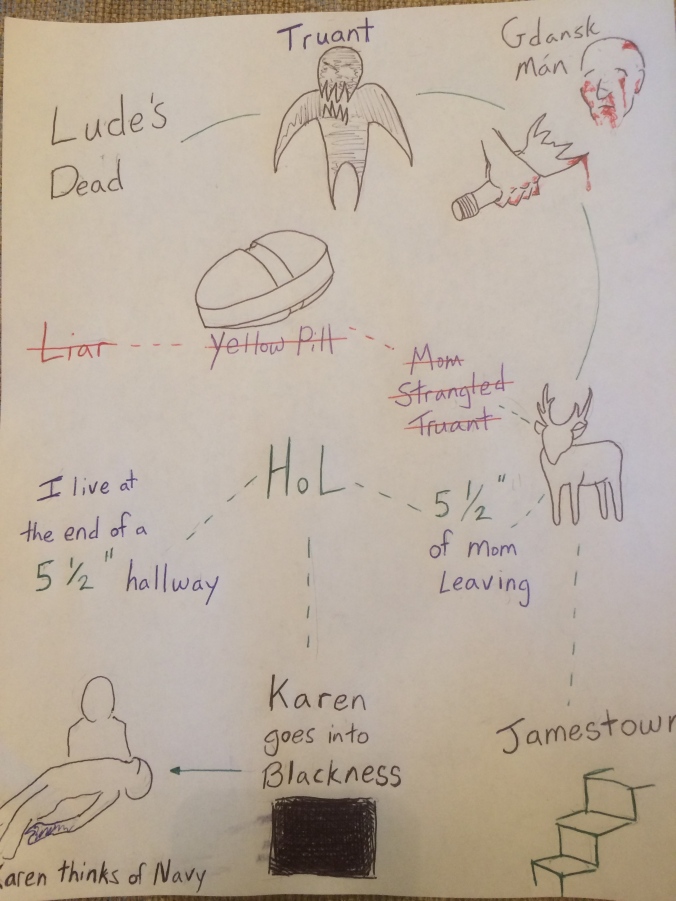
HoL map ch21-23 For Explorer type players
HoL ch 16-20 Map
For this map I focused on Navidson’s possible motivations for returning to the house and then tried to capture Exploration #5. Because Exploration #5 contains so much about open space, emptiness, void and abyss, I included a lot of blank space to represent that aspect. I also left a portion in the lower right absent, and on my table dark, in order to capture the abyss that Navidson finds himself in. It also is bordered with representations of him forgetting and dying from forgetting thus also fading into nothingness himself.
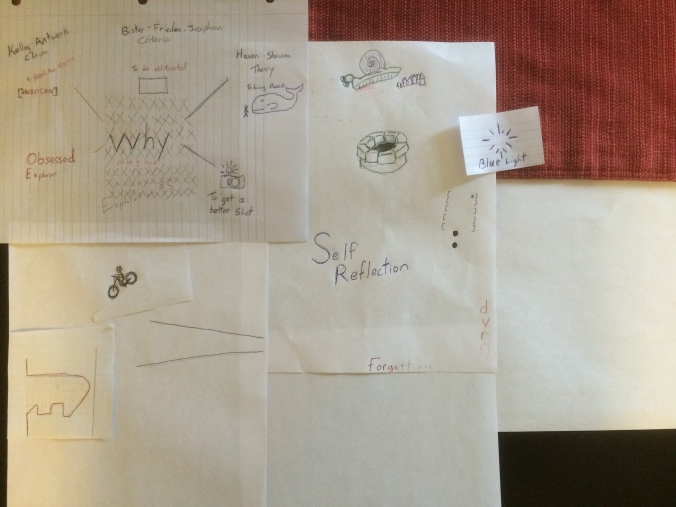
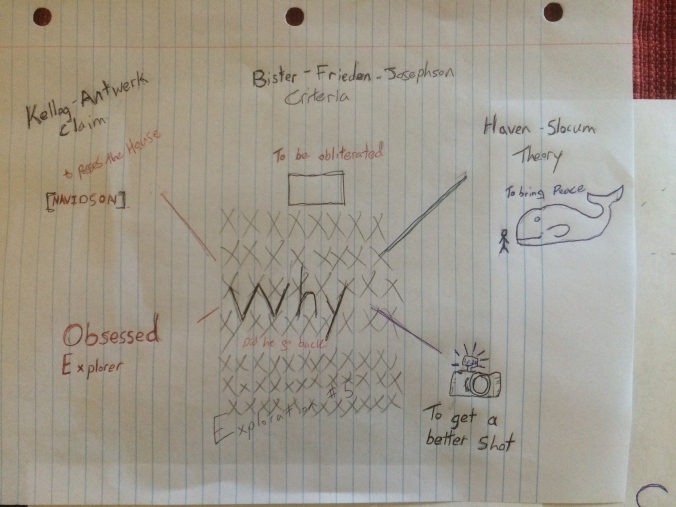
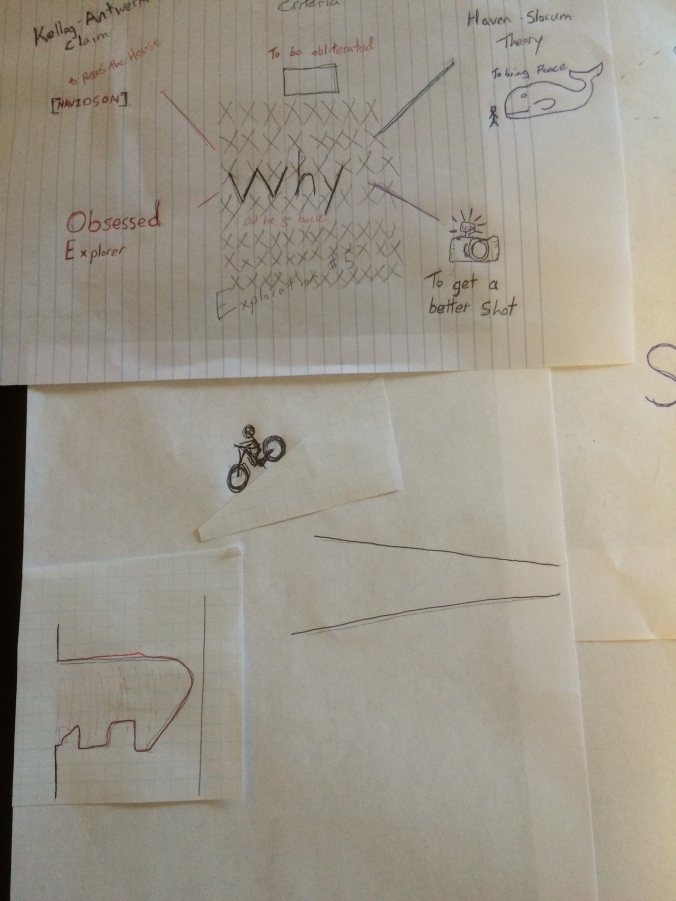
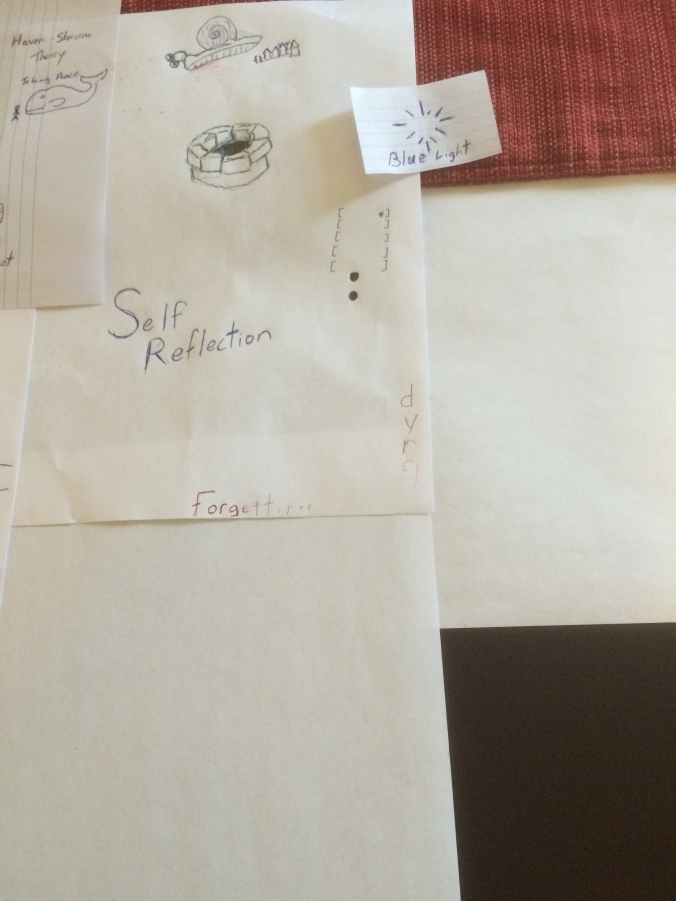
Parallel Play Bastion
The first thing I noticed when watching my partner https://ma108gaming.wordpress.com/ play Bastion was the difference between the PC and console version. The console version lacks the cursor target and depends entirely on character facing direction.
The second thing I noticed was how much more of a seasoned player he is. In terms of movement, he used the roll function a lot in order to speed up travel time instead of the intended use to dodge enemy attacks. However, he also used it quite effectively to dodge attacks as intended. In one portion of the game he picked up a bellows that was used to disperse thorny plants in the way. Occasionally he also used the bellows on some of the enemies. This worked on the plant enemies, but not so much on the monsters and birds. When the bellows proved ineffective he used his gun instead. One specific monster shot poisonous orbs at him which covered the ground. When walking into the puddle left by the orbs the screen became fuzzy and obstructed the players view. My partner quickly learned not to step into the puddles and instead would let them dissipate before moving onto the effected area. My partner also learned that in order to damage a certain flower enemy he had to wait for the flower to open. I watched as he shot at the enemy a few times before realizing it wasn’t taking damage unless it was open. Once learned he then paused and waited for the flower to open and his opportune time to strike. In all, there were occasions of learning taking place. However, as a seasoned gamer, my partner quickly discovered the rules governing the enemies behaviors and followed them to his advantage when playing.
House of Leaves as Simulation
It could be posited that the novel House of Leaves is more like a simulation than a narrative. To make such a claim an understanding of narrative and simulation are required. A narrative consists of a story, which is “all the events that take place in a narrative,” and the plot, which is “the underlying causality which binds the events together” (JHGLTC). The narrative itself is “how all these events with underlying causality are presented” (JHGLTC). A simulation “is the hermeneutic other of narratives; the alternative mode of discourse, bottom up and emergent where stories are top-down and preplanned” (Aarseth). It is easy to see how House of Leaves could be considered a narrative. The novel contains a story, plot and is presented in a narrative form. For example, an account is given of Will Navidson and his experiences in a new house (Danielewski 9). How then could House of leaves be considered more of a simulation?
In order to determine if House of Leaves is a simulation it may help to explore if it meets the requirements of a game. Game theory stipulates that a game have players, strategies, and payoffs (Ross 213). For House of Leaves, the reader can be considered the player. Strategies are formed by the player/reader on which parts of the text to read, what bibliographic code to take note of, and which footnotes and appendices to regard or disregard. For instance, the opening of chapter five gives the reader a quote, the main narrative in the body text, and several footnotes from which to choose (Danielewski, 41). It is unclear what payoffs are offered for differing reader strategies, but for the sake of argument we will assume that the ability to draw connections due to information gleamed from footnotes and appendices to be considered a payoff. Therefore House of Leaves could be considered a simulation game.
A simulation is described as “bottom up and emergent” where “knowledge and experience is created by the player’s actions and strategies, rather than recreated by a writer” (Aarseth). This is where the novel loses its tenuous claim as a simulation. While the player may have a choice as to which sections to read or which appendices to explore, the knowledge is still dictated by the author and what is presented on the page. Wether a reader chooses to read the main narrative, the footnotes, or translate quotes as presented at the start of chapter IX, the knowledge contained therein does not change according to player choice. It is still dictated by the author (Danielewski 107).
For House of Leaves to be considered a simulation the narrative would have to be viewed as only a vehicle to take the player to the next instance of turning the page or deciding what to read or look at. However, the novel contains a narrative from which readers can choose their level of involvement not an experience in which the narrative is arbitrary and can be disregarded.
Works Cited
Aarseth, Espen. “Genre Trouble.” Electronic Book Review, 21 May 2004, http://www.electronicbookreview.com/thread/firstperson/vigilant.
Danielewski, Mark. House of Leaves. Pantheon Books, 2000.
“Narratology.” The Johns Hopkins Guide to Literary Theory and Criticism. 2005, http://litguide.press.jhu.edu.libaccess.sjlibrary.org/cgi-bin/view.cgi?eid=189&query=narrative.
Rauscher, Andreas. “Game Genres.” The Johns Hopkins Guide to Digital Media. Johns Hopkins University Press, 2014.
Get Lamp Summary
As the title discloses, “Get Lamp: The text Adventure Documentary” by Jason Scott is a documentary about the history and current state of text adventures, also called interactive fiction(IF). The film begins with a series of short interview clips. Among the interviewees of these clips is Cave explorer Dave West who talks about a type of game that is similar to caves and would appeal to cavers. Thus the film introduces us to the Bedquilt caves, the inspiration behind the text game Adventure. Adventure was written and developed by Will Crowther, and disseminated through the ARPANET in the late nineteen-seventies to universities and other places with mainframe computers.
Shortly after, Adventureland was created and distributed by Adventure International, the first computer gaming company, for use on personal computers, thus kickstarting computer gaming and IF. Infocom soon followed with Zork. Infocom games represented a “renaissance in game package designs. However, the commercial viability of IF soon floundered as demonstrated by the numerous game companies that closed towards the end of the nineteen-eighties.
The documentary then focuses on the experience of playing IF. IF takes “an investment of time,” as one player states. The investment is required because some puzzles may take fifteen or twenty steps which may not always be obvious. In addition, many IF requires mapping out the world and taking notes while playing. The result is that IF appeals to “people who are logical and methodical.” Mazes and puzzles are staples of IF, acting as gateways that require the player to expend time and energy in order to get the next section of prose. One restriction in IF is that players will inevitably type something into the computer that the program doesn’t understand. Due to limited capacity, authors must therefore write in responses not to all the possibilities of what players may do, but what is the “most common and most interesting” things a player might do.
IF is described as allowing for the greatest level of immersion for people with strong imaginations. It is described that text can tap directly into the imagination. IF takes advantage of this by also allowing the player to give commands in the same language and tools of the virtual world. Thus, the immersion is enhanced instead of broken by player interaction.
The documentary then describes the modern scene of IF. “Over 2,000 new works” of IF have been created since the end of the highth of text adventure popularity. However, the audience that is consuming IF is generally also the same people who write IF. One author described writing IF as giving him a sense of power and control. IF may never gain the same level of popularity, partly because most writers are not the best marketers or salesmen. So, even if IF won’t regain its former prominence, hobbyists are still keeping the genre alive.
“Get Lamp: The Text Adventure Documentary” YouTube, Uploaded by Google Tech Talks, 10 March 2011, https://www.youtube.com/watch?v=LRhbcDzbGSU.